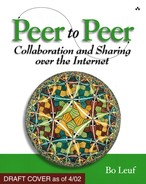Chapter 10. Collaborative P2P Spaces
Collaboration is for many what it’s all about, whatever the technology. Many of the innovative aspects of the Internet as a whole evolved as a direct, or sometimes indirect result of people’s desire to collaborate independently of location. Peer technologies are natural to informal collaborations in many ways, and encourage the forming of such coworking groups of people.
Granted that there is no real substitute yet for real physical presence—for example, one can rather easily determine this fact from models such as the “radiative heat” of information flow and how people communicate and work together. Yet people must often work together even in situations when they are physically remote or at variable locations, and then it becomes vital to lower any and all barriers to effective communication. Informal, p2p groupings are one way to go.
In fact, these informal groupings are the way people often do go, regardless of any formal structures that might be centrally mandated! This tendency is so pervasive, and so ingrained, that most people don’t realize that this is what they’re doing. When asked, they will sincerely maintain that they are working according to the hierarchical work methodology. However, study by outsiders can easily show otherwise—the actual work gets done in a rapid succession of p2p-like contacts.
This last implementation chapter covers those p2p technologies that, perhaps somewhat vaguely, address the context of maintaining “collaborative spaces” where people can meet, communicate, and work together. Some server-client solutions try to do this as well; WikiWiki webs, chat and conferencing tools are just a few examples. The following takes up some distributed p2p solutions.
